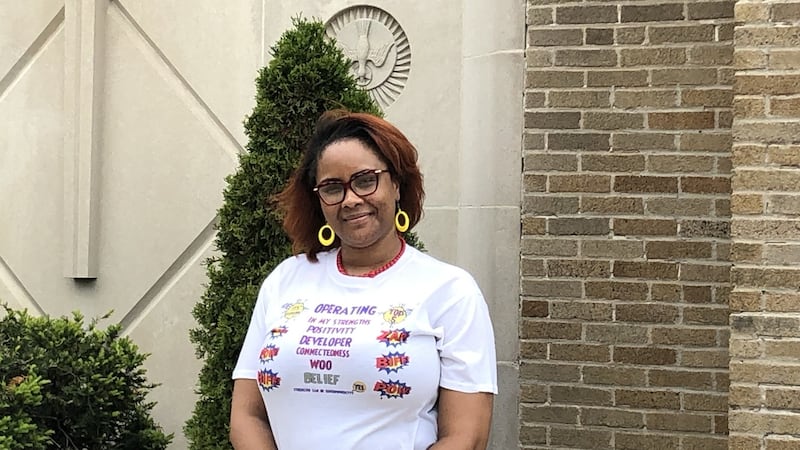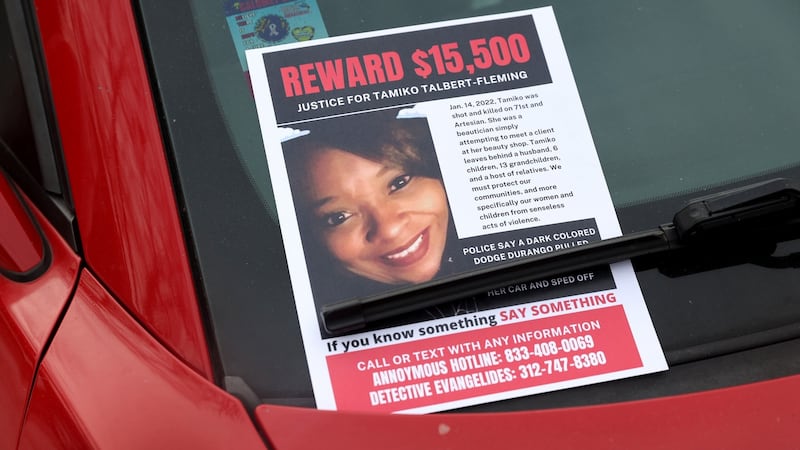Seandell Holliday wanted to be a musician and to open his own studio. However, in a list of career goals he set out in his school he included a rider, “if I make it to 21”.
Asked by his teacher why he had included this condition the 16-year-old youth replied that a lot of things happened in Chicago and that "you see so many kids lose their lives at early ages".
Last Saturday evening, Seandell Holliday was shot dead at the centre of one of Chicago’s main tourist areas.
In a weekend of carnage across different parts of the United States, he was one victim among many.
The mass murders in Buffalo which left 10 people dead following an attack by a heavily-armed gunman – in what police maintain was a racially motivated hate crime – generated worldwide headlines.
The fact that the suspect was 18 years old, had driven more than 300km from his home town, had live streamed the attack and had authored a hate-filled manifesto based around false conspiracies about the white population being replaced by immigrants, shocked many in America and raised new questions about the rhetoric of some politicians and media figures.
The weekend of violence had started on Friday night in Milwaukee, Wisconsin, when 21 people were shot in three separate incidents that occurred in a downtown area
However, overall across America, at least 14 people were killed last weekend in mass shootings and nearly 40 were wounded.
And the toll could have been much higher.
In Laguna Woods, in southern California, one person was killed and five injured at a Taiwanese church in what authorities believe was an attack motivated by political hatred of Taiwan. Officials said the suspect secured some church doors with chains, attempted to nail another closed and sought to disable locks with superglue.
Two semi-automatic pistols and incendiary devices similar to Molotov cocktails were found nearby.
A potential large-scale massacre was averted when the attacker’s gun appeared to jam and he was overpowered by parishioners at the church.
Separately at a bustling flea market in Houston, Texas, on Sunday, where thousands of people were shopping, a gun fight broke out, killing two people and leaving three others critically injured.
The weekend of violence had started on Friday night in Milwaukee, Wisconsin, when 21 people were shot in three separate incidents that occurred in a downtown area where thousands had gathered to watch a basketball game. Police said a row broke out on the street between two groups which led to an exchange of gunfire that left 17 people injured. Over the next two hours there were two other shootings that left an additional four people wounded.

America has experienced many gun atrocities, some linked directly to white supremacy and racial bigotry including the attack in Buffalo, on the synagogue in Pittsburgh in 2018 and the church in Charleston in 2015. Others seemed to stem from other forms of hatred and rage.
However below the level of these major attacks is the gun violence that is taking place on a daily basis. In 2020 there were 19,384 gun-related murders as well as more than 24,000 gun-related suicides. In that year more Americans died of gun-related injuries than in any other year on record.
Over the subsequent years, the numbers have fluctuated but the gun deaths have continued.
US president Joe Biden again this week said he wanted to see weapons of war taken off the streets. However the reality is he does not have the votes in congress to introduce comprehensive gun reforms. Republicans have condemned the Buffalo attack but senior figures have questioned why the government would want to go after law abiding Americans and their second amendment rights to possess firearms.
For gun reforms to be put in place, Biden would need all Democratic party senators and 10 Republicans to back such measures. In the run up to elections in November, that is unlikely. Little, it would appear, is likely to change the short term at least.
The young generation is saying, 'you did not pay attention to us and we are going to make you feel the heat'.
At the University of Chicago there is an institution called the Crime Lab which tracks the levels of violence and designs and tests potential public sector responses to this problem.
From an Irish perspective, the official figures on the levels of gun violence in Chicago are astronomical
Nearly 800 people in the city were shot dead last year. Overall, there were in excess of 3,500 shooting incidents, or almost 10 every day. So far this year, more than 200 people have been killed. Five died last weekend alone.
Crime Lab director Jens Ludwig says, for the black community in Chicago, last year saw more homicides than any other year on record. He says gun violence is linked to racial inequality and poverty and needs a fundamental re-thinking about policing.
Over recent years, two areas in Chicago greatly affected by violence and homicides were Englewood, and East and West Garfield Park.
An organisation called Chicago Survivors works with the families of the victims of gun deaths living in these and other communities. The organisation has responded to more than 1,300 homicides in the last two years, providing 2,000 hours of counselling.
Its director of clinical services, JaShawn Hill, who has seen two close relatives shot dead over recent years, agreed to meet The Irish Times at a church on the south side of the city.
The taxi driver, on receiving the address, warned we would be passing though “some neighbourhoods that are not great”. It was mid afternoon, but he made it clear if it was dark he would not drive through these locations at all.

Along Garfield there were some houses that were boarded up, in some places it appeared properties had been demolished and there seemed a general air of a community that needed investment. However, life was going on. Children were being collected from school, people were doing their shopping.
At the church in a nearby Mexican neighbourhood, Hill says her organisation is dispatched by the police to the location of homicides to work with the grieving families. She says it helps families with funeral planning or with going to the coroner and to advise them of their rights. It assists survivors to access emergency funds, where necessary. She points out in some cases the deceased may have been the sole bread winner.
She says she wanted to become a therapist after her brother was killed in 2008 in an unsolved murder. Some people had “come back years later for my brother for something years ago that the streets say happened”. Tragedy struck her family again last year when her cousin was shot dead in a mass shooting in the city.
Her eyes moisten as she tells the story: “I lost my cousin. He was like a brother. He was the only male cousin after my brother. They were the only two boys. He had just moved his family to a south suburb as he recognised the violence was escalating in his old neighbourhood [when he was killed].”
Hill says there are so many issues behind the violence – untreated trauma, lack of access to healthcare, limited resources to provide a pathway out of poverty. However, she says at the root of most is the need for better mental health services. She says the pandemic and its associated lockdowns also contributed.
She is not surprised the violence is escalating as the young generation is saying, “you did not pay attention to us and we are going to make you feel the heat”.
She says the type of violence is worsening. “I am 41. [When I was younger] you did not worry about getting shot – knives were what you were afraid of. You were afraid you might get stuck, you might get cut. You did not worry about getting shot. That was a high level consequence for an action the community thought was unacceptable.”
She says now there are more people about “who are untreated, hypervigilant, paranoid [and] respond with weapons”.
Violence surrounding replacement theory is not an aberration, it is a feature of that anti-Semitic conspiracy
Hill also maintains that while gentrification of parts of Chicago has been very good for the city, it has had a downside. Homes for poor communities were torn down in the process and people moved to the suburbs without proper preparation for their new environments.
Eric Ward is a senior fellow at the Southern Poverty Law Center and executive director of the Western States Center, organisations which monitor and seek to tackle hate crime. He says the scale of violence in the United States is horrifying. "It is so normalised now in the US that people are barely phased by it. In terms of gun violence, it is almost like a soft war where you quickly normalise it and become accustomed to the deaths and injury around it. It is now happening at a societal level. It is quite frightening."
He believes there is more to the phenomenon than just easy access to guns – there are other parts of the world where people can get firearms readily without experiencing the mass shootings seen in the United States. “I think the other things that are going on are America has an obsession with violence and it has largely come from the rhetoric of elected officials and the entertainment sector. It has had an incredible influence.”
Ward says researchers believe most mass shootings in America are not motivated by overt forms of bigotry. “However, increasingly in the United States, we are documenting they are motivated by prejudices due to race religion, gender, sexual orientation and national identity. It is quite concerning that we are identifying more acts like this at the same time elected officials are steeping an environment that encourages and makes space for violence.”
The president went to Buffalo this week following the murders there and in a stirring speech promised that evil would not win and hate would not prevail. He urged Americans to reject the “poison” of white supremacy.
However, Ward believes more political violence is inevitable. He says the federal government needs to step up its actions. He says one third of Americans believe in some form of the great replacement theory. He says this is a belief that there is a secret Jewish conspiracy to destroy white American Christians. “Violence surrounding replacement theory is not an aberration, it is a feature of that anti-Semitic conspiracy. We will absolutely see more acts of mass violence.”
He says all Americans should campaign to have politicians from the lowest to the highest publicly reject the replacement theory. And he says the federal government needs to rein in social media platforms that are allowing the violent rhetoric of genocide to proliferate.
In Buffalo, Biden denounced what he termed domestic terrorism. In April, he announced a crackdown on what are known as “ghost guns” – weapons that can be made from kits at home and have no identifying serial numbers. However, in the aftermath of the massacre last weekend, he acknowledged it would be difficult to get the US congress to act on restricting access to guns.
He also condemned those “who spread the lie [of the replacement theory] for power, political gain and for profit” – though he did not single out any of the right-wing media personalities who have promoted this idea.
Back in Chicago, meanwhile, as it prepares for another weekend of shootings and deaths, local Democratic congressman Mike Quigley says every day Chicagoans are telling him about their worries over violence in the city. "They see it in their neighbourhoods and tragically, many of them experience it in real time. Doing nothing is simply not an option."










